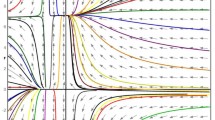Abstract
We consider a stage-structured model of a harvested fish population and we are interested in the problem of estimating the unknown stock state for each class. The model used in this work to describe the dynamical evolution of the population is a discrete time system including a nonlinear recruitment relationship. To estimate the stock state, we build an observer for the considered fish model. This observer is an auxiliary dynamical system that uses the catch data over each time interval and gives a dynamical estimate of the stock state for each stage class. The observer works well even if the recruitment function in the considered model is not well known. The same problem for an age-structured model has been addressed in a previous work (Ngom et al., Math. Biosci. Eng. 5(2):337–354, 2008).
Similar content being viewed by others
References
Albertos, P. (1990). Block multirate Input–Output model for sampled-Data control systems. IEEE Trans. Autom. Control, 35, 1085–1088.
Anderson, B. D. O., & Moore, J. B. (1979). Optimal filering. Englewood Cliffs: Prentice Hall.
Anderson, B. D. O., & Moore, J. B. (1981). Detectability and stabilizability of time-varying discrete-time linear systems. SIAM J. Control Optim., 19(1), 20–32.
Anon (2001). Advisory Committee on Fisheries Management (ACFM): Report of the Arctic Fisheries Working Group. ICES CM 2001/ACFM:19.
Baras, J. S., Bensoussan, A., & James, M. R. (1988). Dynamic observers as asymptotic limits of recursive filters: special cases. SIAM J. Appl. Math., 48(5), 1147–1158.
Beverton, R. J. H., & Holt, S. J. (1957). On the dynamics of exploited fish populations. London: Chapman & Hall.
Bhattacharyya, S. P. (1978). Observer design for linear system with unknown inputs. IEEE Trans. Autom. Control, 23, 483–484.
Boutayeb, M., & Darouach, M. (2000). Observers design for linear time-varying systems. In 39th IEEE CDC (pp. 3183–3187).
Corliss, G. F. (1989). Survey of interval algorithms for ordinary differential equations. Appl. Math. Comput., 31, 112–120.
Darouach, M., Zasadzinski, M., & Xu, S. J. (1994). Full-order observer for linear systems with unknown inputs. IEEE Trans. Autom. Control, 39(3), 606–609.
FAO (1987). Rapport du deuxième groupe de travail AD HOC sur les Chinchards et les Maquereaux de la zone nord du COPACE. Organisation des Nations Unies pour l’Alimentation et l’Agriculture, Rome. http://www.fao.org/DOCREP/003/S4882F/S4882F09.htm.
Getz, W. M., & Haight, R. G. (1989). Monographs in population biology: Vol. 27. Population harvesting. Demographic models of fish, forest, and animal resources. Princeton: Princeton University Press.
Hou, M., & Muller, P. C. (1994). Disturbance decoupled observer design: a unified viewpoint. IEEE Trans. Autom. Control, 39(6), 1338–1341.
Hou, M., & Muller, P. C. (1992). Design of observers for linear systems with unknown inputs. IEEE Trans. Autom. Control, 37, 872–875.
Hostetter, G., & Meditch, J. (1973). Observing systems with unmeasurable inputs. IEEE Trans. Autom. Control, 18, 307–308.
Iggidr, A. (2004). Controllability, observability and stability of mathematical models. In J. A. Filar (Ed.), Mathematical models. Encyclopedia of life support systems (EOLSS). Oxford: Eolss Publishers. Developed under the auspices of the UNESCO, http://www.eolss.net.
Jaulin, L., Braems, I., Kieffer, M., & Walter, E. (2001). Guaranteed nonlinear estimation using constraint propagation on sets. Int. J. Control, 74(18), 1772–1782.
Jin, J., Tank, M. J., & Park, C. (1997). Time-delayed state and unknown input observation. Int. J. Control, 66(5), 733–745.
Johnson, C. (1975). An observers for systems with unknown and inaccessible inputs. IEEE Trans. Autom. Control, 21, 825–831.
Kamen, E. W. (1993). Block form observers for linear time-varying discrete-time systems. In Proc. IEEE conference on decision and control, San Antonio, USA (pp. 355–356).
Kamen, E. W. (1992). Study of linear time-varying discrete-time systems in terms of time-compressed models. In Proc. IEEE conference on decision and control, USA (pp. 3070–3075).
Kurzhanski, A., & Valyi, I. (1997). Ellipsoidal calculus for estimation and control. Boston: Birkhauser.
Luenberger, D. G. (1971). An introduction to observers. IEEE Trans. Autom. Control, AC-16(6), 596–602.
Magal, P., & Pelletier, D. (1997). A fixed point theorem with application to a model of population dynamics. J. Differ. Equ. Appl., 3(1), 65–87.
Moore, J. B., & Anderson, B. D. O. (1980). Coping with singular transition matrices in estimation and control stability theory. Int. J. Control, 31, 571–586.
Ngom, D., Iggidr, A., Guiro, A., & Ouahbi, A. (2008). An observer for a nonlinear age-structured model of a harvested fish population. Math. Biosci. Eng., 5(2), 337–354.
Nikoukhah, R., Campbell, S. L., & Delebecque, F. (1998). Observer design for general linear time-invariant systems. Automatica, 34(3), 575–583.
Rapaport, A., & Gouzé, J. L. (2003). Parallelotopic and practical observers for non-linear uncertain systems. Int. J. Control, 76(3), 237–251.
Rihm, R. (1994). Interval methods for initial value problems in ODEs. In Topics in validated computations. Amsterdam: Elsevier (pp. 173–208).
Ricker, W. E. (1954). Stock and recruitment. J. Fish. Res. Board Can., 11, 559–623.
Shepherd, J. G. (1982). A family of general production curves for exploited populations. Math. Biosci., 59, 77–93.
Sheweppe, F. C. (1968). Recursive state estimation: unknown but bounded errors and systems inputs. IEEE Trans. Autom. Control, 13(1), 22–28.
Sundaram, S., & Hadjicostis, C. N. (2007). Delays observers for linear systems with unknown inputs. IEEE Trans. Autom. Control, 52, 334–339.
Sontag, E. D. (1998). Texts in applied mathematics: Vol. 6. Mathematical control theory. Deterministic finite-dimensional systems. New York: Springer.
Valcher, M. E. (1999). State observers for discrete-time linear systems with unknown inputs. IEEE Trans. Autom. Control, 44(2), 397–401.
Wikan, A., & Eide, A. (2004). An analysis of a nonlinear stage-structured cannibalism model with application to the northeast arctic cod stock. Bull. Math. Biol., 66, 1685–1704.
Yang, F., & Wilde, R. W. (1975). Observers for linear systems with unknown inputs. IEEE Trans. Autom. Control, 20, 716–717.
Author information
Authors and Affiliations
Corresponding author
Rights and permissions
About this article
Cite this article
Guiro, A., Iggidr, A. & Ngom, D. On the Stock Estimation for a Harvested Fish Population. Bull Math Biol 74, 116–142 (2012). https://doi.org/10.1007/s11538-011-9667-z
Received:
Accepted:
Published:
Issue Date:
DOI: https://doi.org/10.1007/s11538-011-9667-z




